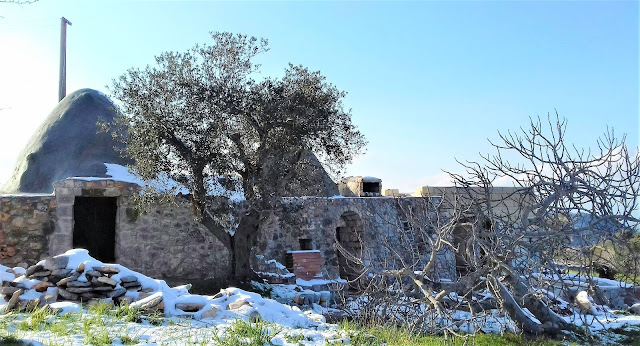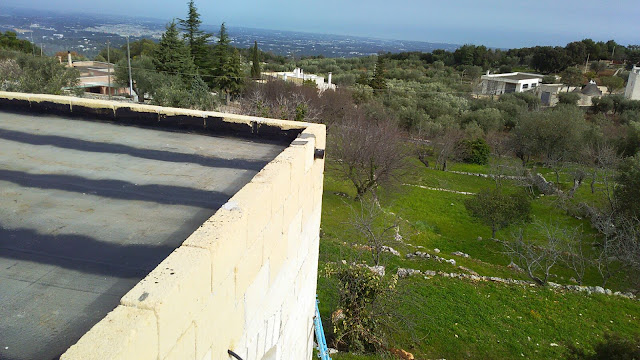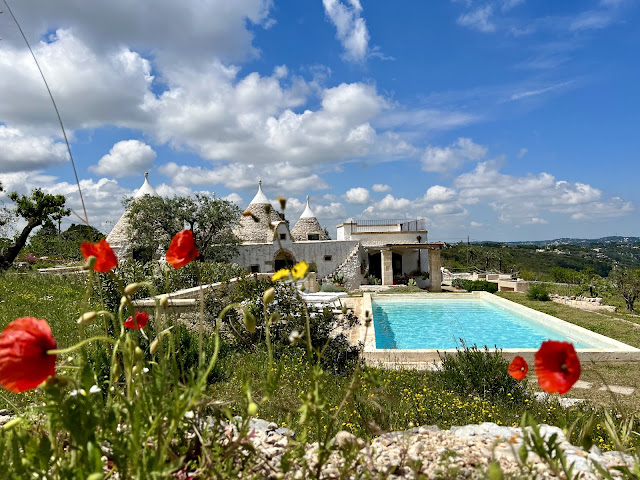Snow in Puglia
It has been a few weeks since I last wrote about the pile ' rocks because there's been little to report: the Beast from the East - the Siberian blast that hit Europe first and subsequently, the UK - pretty much stopped work for the better part of February.
Mimmo, the builder is usually prolific with photo updates on Whatsapp but last month, the site was deluged by a week of rain and then the wind and snows came - unusual for southern Italy and uncomfortable for workers who are used to more than 300 days of sunshine a year. There were no happy face emojis from him in February, that's for sure!
Still, it is pretty exciting to see that the lamia, the new build part of the project, is now up and waterproof and that all the pipework necessary to make these ancient rural huts liveable is laid or underway.
Puglian authorities only allow you to extend to a maximum of 20 per cent of the original footprint of the old buildings and anything new must be built in keeping with the vernacular - the lamie are the characteristic, square stone farm buildings with flat roofs and a barrel vaulted ceiling inside. We've decided that our roof will become a little terrazzo to soak in the views (and have an aperitif at sunset woohooo!!)
We are restricted too in windows and sizes - traditionally they had very few for heat retention in winter and keeping cool in summer so we have had to be strategic in placement to take advantage of the views.
Mortar, which wasn't used in the ancient construction techniques for the trulli, is being used in parts of the old building to ensure that they conform to modern safety standards although none will be visible internally or externally or in the domes themselves. Traditionally, the exteriors and interiors of the trulli bodies were whitewashed to the beginning of the cones and we plan to stick to tradition although a lot of English people who have been restoring these buildings in past years like to keep the stone untouched.
What do you prefer?
 |
| Trullo English style |
 |
| Trullo traditional Puglian style |
A coat of white paint every couple of years keeps them fresh - and cool in the hot summers. I love the look of the white against the blue skies. The cone stone is left untouched although the pinnacles, often different shapes, will be whitewashed too.
Rather wonderful too is that the old water cistern is fully restored and functional.
The so-called Murgia of Puglia, which is where we are, is a karst plateau, a topography created by the dissolution of soluble rocks such as limestones, dolomite and gypsum.
It is characterised by underground drainage systems with sinkholes and caves.
This means that in winter, the rains drain through the soil into fissures int the strata of limestone bedrock and flow through underground watercourses into the Adriatic Sea.
There is no permanent surface water so it is trapped in catchments and cisterns - and below is ours. They are lovely old things and we are so very happy to re use ours.
Pretty isn't it? Inside it is huge and has a vaulted ceiling too!
And here is Robert standing on it when it was just a pile o'rocks.
Next week, I will report from on site as we have taken advantage of el cheapo winter tickets and are going to visit In Real Life! (p.s. London to Bari £49 return, how good is that?!)








Comments
Post a Comment